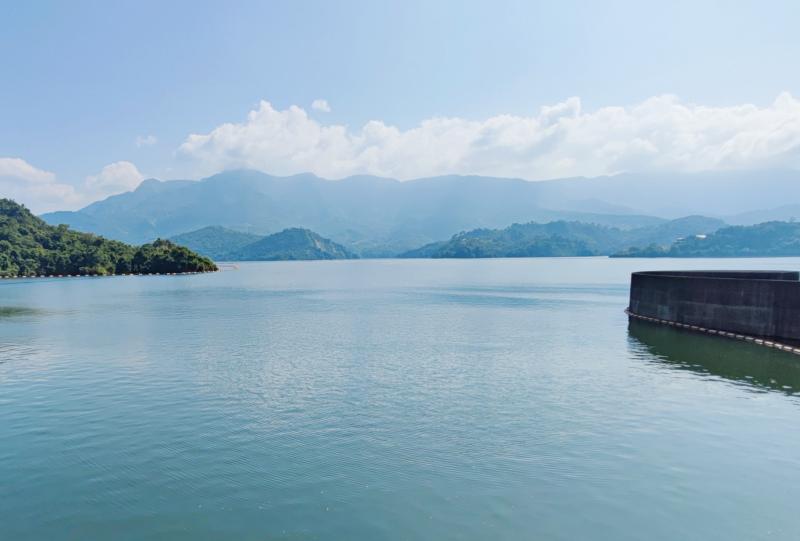The water level at the nation’s largest reservoir is at its highest for November in the 50 years it has been operational, leaving behind drought concerns of recent years, Southern Region Water Resources Office data showed on Wednesday.
The Zengwen Reservoir (曾文水庫), which spans Chiayi County and Tainan, was at 98.55 percent capacity as of 9am on Wednesday, even after releasing water to Tainan’s Wushantou Reservoir (烏山頭水庫), data showed.
The water level had climbed to 229.61m, only 39cm short of full capacity, the office said.

Photo: Wu Chun-feng, Taipei Times
This is compared to the 6.21 percent capacity seen on May 28, the lowest this year, data showed.
Thanks to continuous rainfall in the catchment area and water management by the office, the reservoir was filled on Sept. 11, the office said.
Combined water levels at the Zengwen and Wushantou reservoirs are 2.5 times what they were this time last year, and even 186 million cubic meters more than after Typhoon Morakot in 2009, it said.
The last time the reservoir was full in November was in 2017, but the water level was slightly short of this year’s height at 227m and began falling only four days into the month, the office said.

An essay competition jointly organized by a local writing society and a publisher affiliated with the Chinese Communist Party (CCP) might have contravened the Act Governing Relations Between the People of the Taiwan Area and the Mainland Area (臺灣地區與大陸地區人民關係條例), the Mainland Affairs Council (MAC) said on Thursday. “In this case, the partner organization is clearly an agency under the CCP’s Fujian Provincial Committee,” MAC Deputy Minister and spokesperson Liang Wen-chieh (梁文傑) said at a news briefing in Taipei. “It also involves bringing Taiwanese students to China with all-expenses-paid arrangements to attend award ceremonies and camps,” Liang said. Those two “characteristics” are typically sufficient

A magnitude 5.9 earthquake that struck about 33km off the coast of Hualien City was the "main shock" in a series of quakes in the area, with aftershocks expected over the next three days, the Central Weather Administration (CWA) said yesterday. Prior to the magnitude 5.9 quake shaking most of Taiwan at 6:53pm yesterday, six other earthquakes stronger than a magnitude of 4, starting with a magnitude 5.5 quake at 6:09pm, occurred in the area. CWA Seismological Center Director Wu Chien-fu (吳健富) confirmed that the quakes were all part of the same series and that the magnitude 5.5 temblor was

The Central Weather Administration has issued a heat alert for southeastern Taiwan, warning of temperatures as high as 36°C today, while alerting some coastal areas of strong winds later in the day. Kaohsiung’s Neimen District (內門) and Pingtung County’s Neipu Township (內埔) are under an orange heat alert, which warns of temperatures as high as 36°C for three consecutive days, the CWA said, citing southwest winds. The heat would also extend to Tainan’s Nansi (楠西) and Yujing (玉井) districts, as well as Pingtung’s Gaoshu (高樹), Yanpu (鹽埔) and Majia (瑪家) townships, it said, forecasting highs of up to 36°C in those areas

The brilliant blue waters, thick foliage and bucolic atmosphere on this seemingly idyllic archipelago deep in the Pacific Ocean belie the key role it now plays in a titanic geopolitical struggle. Palau is again on the front line as China, and the US and its allies prepare their forces in an intensifying contest for control over the Asia-Pacific region. The democratic nation of just 17,000 people hosts US-controlled airstrips and soon-to-be-completed radar installations that the US military describes as “critical” to monitoring vast swathes of water and airspace. It is also a key piece of the second island chain, a string of